Management of cervical spine injuries in athletes
- PMID: 17597954
- PMCID: PMC1896065
Management of cervical spine injuries in athletes
Abstract
Objective: Although the incidence of catastrophic cervical spine injury in sport has been significantly reduced over the past 3 decades, the injury warrants continued attention because of the altered quality of life that often accompanies such an injury. The purpose of our literature review was to provide athletic trainers with an understanding of the mechanisms, anatomical structures, and complications often associated with sport-related cervical spine injury. We also present the most current recommendations for management and treatment of these potentially catastrophic injuries.
Data sources: A review of the most pertinent literature between 1970 and 2005 was conducted using MEDLINE and the search terms spinal cord injury, cervical spine injury, neurosurgical trauma, cervical spinal stenosis, and catastrophic spine injury.
Data synthesis: Flexion of the head places the cervical spine into a straight line and prevents the neck musculature from assisting in force absorption. This mechanism is the primary cause of cervical fracture, dislocation, and quadriplegia. The most serious of the syndromes described in the literature involves a complete spinal cord injury with transverse myelopathy. This injury typically results in total loss of spinal function below the level of the lesion.
Conclusions/recommendations: Spinal trauma may result in a variety of clinical syndromes, according to the type and severity of the impact and bony displacement, as well as subsequent secondary insults such as hemorrhage, ischemia, and edema. Athletic trainers should be prepared to promptly recognize these potentially catastrophic injuries and follow the recommendations of the Inter-Association Task Force for the Appropriate Care of the Spine Injured Athlete in managing such injuries.
Figures
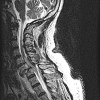
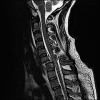
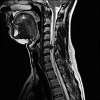
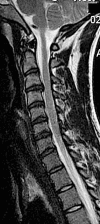

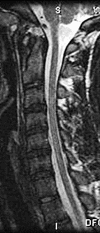
Similar articles
-
Management of cervical spine injuries in athletes.Clin Sports Med. 1989 Jan;8(1):43-58. Clin Sports Med. 1989. PMID: 2663178 Review.
-
Cervical spine injuries in children: a review of 103 patients treated consecutively at a level 1 pediatric trauma center.J Pediatr Surg. 2001 Aug;36(8):1107-14. doi: 10.1053/jpsu.2001.25665. J Pediatr Surg. 2001. PMID: 11479837 Review.
-
Return to play after cervical spine injury in sports.Curr Sports Med Rep. 2013 Jan-Feb;12(1):14-7. doi: 10.1249/JSR.0b013e31827dc1fb. Curr Sports Med Rep. 2013. PMID: 23314078 Review.
-
Cervical spine injury management in the helmeted athlete.Curr Sports Med Rep. 2011 Jan-Feb;10(1):45-9. doi: 10.1249/JSR.0b013e3182073767. Curr Sports Med Rep. 2011. PMID: 21228651 Review.
-
Summary of the National Athletic Trainers' Association position statement on the acute management of the cervical spine-injured athlete.Phys Sportsmed. 2009 Dec;37(4):20-30. doi: 10.3810/psm.2009.12.1738. Phys Sportsmed. 2009. PMID: 20048537
Cited by
-
Cervical spine immobilization in sports related injuries: review of current guidelines and a case study of an injured athlete.Open Orthop J. 2012;6:548-52. doi: 10.2174/1874325001206010548. Epub 2012 Nov 30. Open Orthop J. 2012. PMID: 23248726 Free PMC article.
-
CHARACTERIZATION OF CERVICAL SPINE IMPAIRMENTS IN CHILDREN AND ADOLESCENTS POST-CONCUSSION.Int J Sports Phys Ther. 2019 Apr;14(2):282-295. Int J Sports Phys Ther. 2019. PMID: 30997280 Free PMC article.
-
Football (soccer)-related spinal cord injury-reported cases from 1976 to 2020.Spinal Cord Ser Cases. 2020 Nov 30;6(1):106. doi: 10.1038/s41394-020-00360-8. Spinal Cord Ser Cases. 2020. PMID: 33257665 Free PMC article.
-
Sport, doping and male fertility.Reprod Biol Endocrinol. 2018 Nov 12;16(1):114. doi: 10.1186/s12958-018-0435-x. Reprod Biol Endocrinol. 2018. PMID: 30415644 Free PMC article. Review.
-
The association between contact sport exposure and cervical sensorimotor dysfunction: a scoping review of implications for future musculoskeletal injury risk.Chiropr Man Therap. 2022 Nov 24;30(1):50. doi: 10.1186/s12998-022-00458-w. Chiropr Man Therap. 2022. PMID: 36434725 Free PMC article.
References
-
- Schneider RC. Head and Neck Injuries in Football: Mechanisms, Treatment and Prevention. Baltimore, MD: Williams & Wilkins; 1973.
-
- Maroon JC, Healion T. Head and neck injuries in football. J Indiana State Med Assoc. 1970;63:995–999. - PubMed
-
- Mueller FO, Blythe CS. Catastrophic head and neck injuries. Physician Sportsmed. 1979;7((10)):71–74. - PubMed
-
- Cantu RC, Mueller FO. Catastrophic spine injuries in American football, 1977-2001. Neurosurgery. 2003;53:358–363. - PubMed
-
- Mueller FO, Cantu RC. National Center for Catastrophic Sports Injury 22nd Annual Report. Chapel Hill, NC: National Collegiate Athletic Association, American Football Coaches Association, and the National Federation of State High School Associations; 2004.
Publication types
MeSH terms
LinkOut - more resources
Full Text Sources
Medical
Miscellaneous
